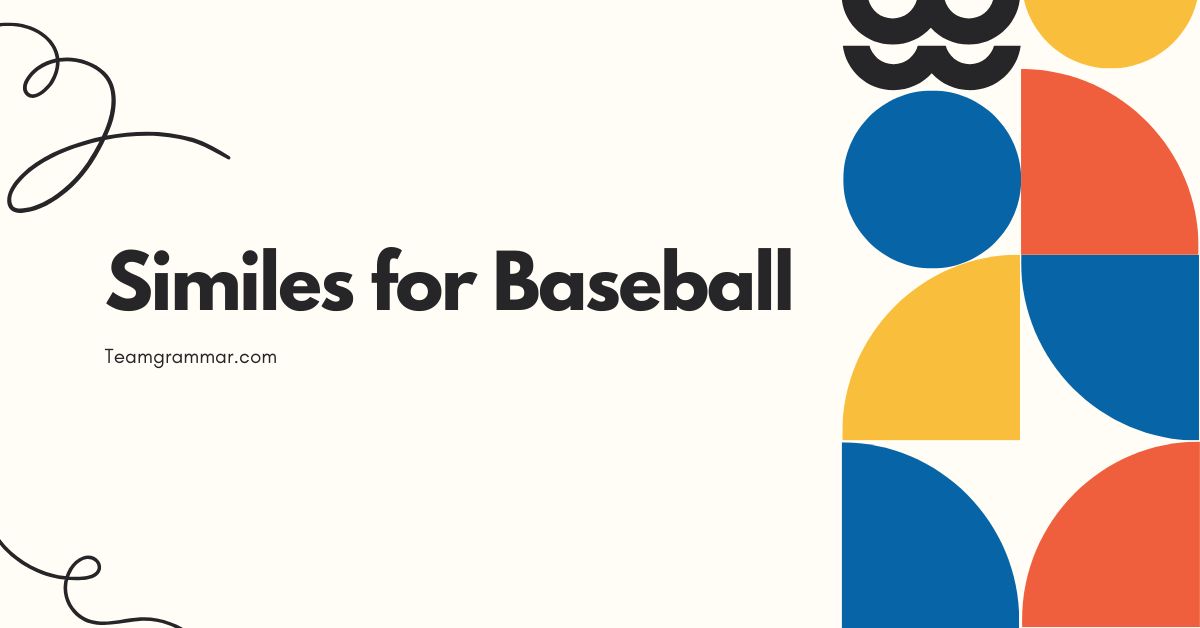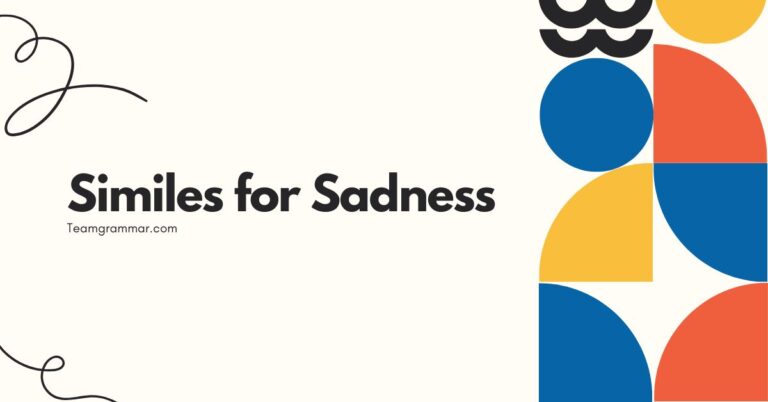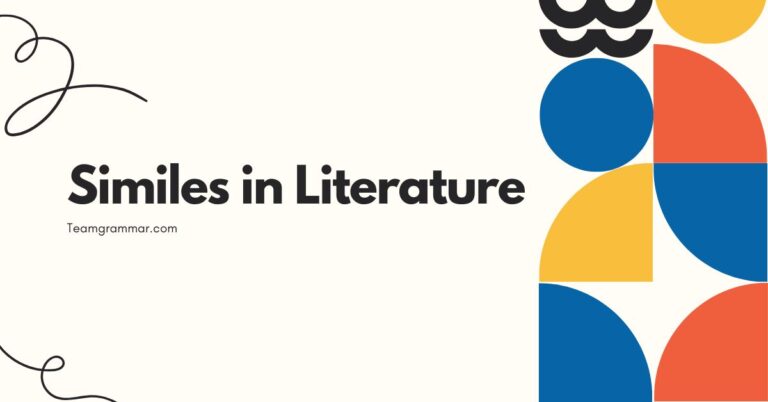33 Similes for Baseball: A Comprehensive Guide to Figurative Language
Understanding similes is crucial for enriching your writing and speech, especially when describing vivid scenes or actions. In English grammar, similes add color and depth, making descriptions more engaging.
This guide focuses on similes related to baseball, offering a unique approach to learning figurative language. Whether you’re a student, writer, or baseball enthusiast, this article will enhance your understanding and appreciation of similes in a fun and practical context.
Table of Contents
- Definition of a Simile
- Structural Breakdown of Similes
- Types of Similes
- Examples of Baseball Similes
- Usage Rules for Similes
- Common Mistakes with Similes
- Practice Exercises
- Advanced Topics: Metaphor vs. Simile
- Frequently Asked Questions
- Conclusion
Definition of a Simile
A simile is a figure of speech that compares two different things using the words “like” or “as.” It highlights a shared quality between these dissimilar entities, creating a vivid and relatable image in the reader’s mind. Similes are essential for adding descriptive power and emotional resonance to language.
Classification of Similes
Similes fall under the broader category of figurative language, which includes metaphors, personification, and hyperbole. Unlike metaphors, which directly equate two things, similes make a comparison explicitly using “like” or “as.” This direct comparison makes similes easier to identify and understand.
Function of Similes
The primary function of a simile is to enhance description. By comparing something unfamiliar to something familiar, similes help readers grasp abstract concepts or visualize complex scenes more easily.
In baseball, similes can vividly describe the speed of a pitch, the grace of a catch, or the intensity of a game.
Contexts for Using Similes
Similes are versatile and can be used in various contexts, including literature, poetry, everyday conversation, and sports commentary. In baseball, commentators and writers often use similes to make the game more exciting and relatable to the audience.
For example, describing a fastball as “fast as a rocket” immediately conveys its incredible speed.
Structural Breakdown of Similes
Understanding the structure of a simile is key to creating effective comparisons. A typical simile consists of two main components: the subject (the thing being described) and the vehicle (the thing it is being compared to), connected by the words “like” or “as.”
Subject
The subject is the entity or aspect being described. In baseball similes, the subject could be a player’s speed, the trajectory of a ball, or the feeling of hitting a home run.
Vehicle
The vehicle is the entity used for comparison. It should be something familiar to the audience, allowing them to understand the subject better.
Common vehicles in baseball similes include animals (e.g., a cheetah for speed), objects (e.g., a rocket for speed), or natural phenomena (e.g., lightning for power).
Connective Words: “Like” and “As”
The words “like” and “as” are the glue that holds the simile together. “Like” is used to suggest similarity, while “as” can be used in several constructions, such as “as [adjective] as” or “as [verb] as.” The choice between “like” and “as” often depends on the specific comparison being made and the desired effect.
Types of Similes
Similes can be categorized based on the type of comparison they make or the effect they create. Here are a few common types:
Descriptive Similes
These similes focus on describing a physical attribute or quality. They often use adjectives to highlight the similarity between the subject and the vehicle.
For example, “The ball was as round as the moon” is a descriptive simile emphasizing the shape of the baseball.
Action-Oriented Similes
These similes describe an action or behavior, often using verbs to draw the comparison. For instance, “He runs like the wind” describes the speed of a runner by comparing it to the wind.
Emotional Similes
These similes convey an emotional state or feeling. They help readers understand the emotional impact of a situation by comparing it to a familiar emotion or experience.
For example, “The crowd roared like a thunderous storm” conveys the intensity and excitement of the fans.
Examples of Baseball Similes
Here are numerous examples of similes related to baseball, categorized for clarity.
Descriptive Similes in Baseball
These similes describe the physical attributes of players, equipment, or the field.
| Simile | Explanation |
|---|---|
| The baseball was as white as snow. | Describes the color of the baseball. |
| The bat was as heavy as a log. | Describes the weight of the bat. |
| The field was as green as an emerald. | Describes the color of the baseball field. |
| His glove was as worn as an old shoe. | Describes the condition of the glove. |
| The pitcher’s mound was as firm as concrete. | Describes the solidity of the mound. |
| The stadium lights were as bright as the sun. | Describes the intensity of the lights. |
| The scoreboard was as big as a billboard. | Describes the size of the scoreboard. |
| The catcher’s mask was as hard as steel. | Describes the material of the mask. |
| The rosin bag was as dusty as an old book. | Describes the texture of the rosin bag. |
| The base path was as smooth as glass. | Describes the evenness of the path. |
| His batting stance was as rigid as a statue. | Describes the stiffness of the stance. |
| The baseball diamond was as symmetrical as a square. | Describes the shape of the diamond. |
| The outfield grass was as soft as a carpet. | Describes the texture of the outfield. |
| The baseball seams were as tight as a drum. | Describes the tightness of the seams. |
| The baseball cap was as new as a daisy. | Describes the newness of the cap. |
| His uniform was as clean as a whistle. | Describes the cleanliness of the uniform. |
| The baseball’s curve was as round as an orbit. | Describes the curve of the baseball. |
| The batter’s grip was as tight as a vise. | Describes the grip of the batter. |
| The umpire’s call was as loud as a gunshot. | Describes the sound of the umpire’s call. |
| The baseball’s landing was as soft as a feather. | Describes the landing of the ball. |
| The batter’s swing was as swift as lightning. | Describes the speed of the swing. |
| The stadium’s echo was as deep as a canyon. | Describes the depth of the echo. |
| The crowd’s cheer was as warm as the sun. | Describes the warmth of the cheer. |
Action-Oriented Similes in Baseball
These similes describe the actions and movements of players during the game.
| Simile | Explanation |
|---|---|
| He throws the ball like a rocket. | Describes the speed and force of his throw. |
| He runs like a cheetah. | Describes his speed on the base path. |
| He catches the ball like a magnet. | Describes his ability to catch the ball effortlessly. |
| He swings the bat like a lumberjack. | Describes his powerful swing. |
| He slides into base like a greased pig. | Describes his smooth and fast slide. |
| He fields the grounder like a vacuum cleaner. | Describes his efficient fielding. |
| He jumps for the catch like a salmon. | Describes his leaping ability. |
| He watches the ball like a hawk. | Describes his focused attention on the ball. |
| He pivots like a dancer. | Describes his graceful movement. |
| He dives for the ball like a dolphin. | Describes his diving ability. |
| He dodges the tag like a matador. | Describes his agility in avoiding the tag. |
| He sprints to first like a bullet. | Describes his speed running to first base. |
| He steals bases like a phantom. | Describes his stealth and speed in stealing bases. |
| He bats the ball away like a fly. | Describes his quick reaction to the pitch. |
| He rounds the bases like a whirlwind. | Describes his speed and energy running the bases. |
| He bunts the ball like a surgeon. | Describes his precision in bunting. |
| He throws strikes like a machine. | Describes his consistency in throwing strikes. |
| He grips the bat like a lifeline. | Describes his strong and secure grip on the bat. |
| He steps to the plate like a warrior. | Describes his confident and determined approach. |
| He hits the ball like a cannon. | Describes the force with which he hits the ball. |
| He moves on the field like a chess piece. | Describes his strategic movement on the field. |
| He communicates with the coach like an actor on stage. | Describes his expressive way of communicating. |
| He strategizes his next move like a general. | Describes his strategic planning. |
Emotional Similes in Baseball
These similes convey the emotions and feelings associated with the game of baseball.
| Simile | Explanation |
|---|---|
| The crowd roared like a thunderous storm. | Describes the loudness and intensity of the crowd’s cheer. |
| His disappointment was as heavy as lead. | Describes the weight of his disappointment after a loss. |
| The tension in the stadium was as thick as fog. | Describes the palpable tension during a critical moment. |
| The joy of winning was like a burst of sunshine. | Describes the happiness and elation of winning. |
| His nervousness was like butterflies in his stomach. | Describes his anxiety before an important play. |
| The pressure to perform was as immense as the ocean. | Describes the overwhelming pressure he felt. |
| The relief of catching the final out was like a cool breeze. | Describes the calming feeling of relief after a successful play. |
| The despair of losing was as bitter as medicine. | Describes the unpleasant feeling of losing. |
| His determination was as strong as steel. | Describes his unwavering resolve. |
| The anticipation was as electric as a lightning strike. | Describes the excitement and anticipation before a game. |
| The feeling of hitting a home run was like flying. | Describes the exhilarating feeling of hitting a home run. |
| The camaraderie among teammates was as warm as a fire. | Describes the close bond between players. |
| His focus was as sharp as a razor. | Describes his intense concentration. |
| The hope for a comeback was as fragile as glass. | Describes the delicate nature of their chances. |
| The fear of striking out was like a dark cloud. | Describes the looming fear of failure. |
| The excitement of the playoffs was like a fever. | Describes the intense excitement of the playoffs. |
| His passion for the game was as deep as the ocean. | Describes his profound love for baseball. |
| The sadness of retirement was like a farewell to a friend. | Describes the emotional impact of leaving the game. |
| The thrill of the game was like riding a rollercoaster. | Describes the exciting sensation of playing baseball. |
| The weight of expectations was as heavy as a mountain. | Describes the pressure of high expectations. |
Usage Rules for Similes
Using similes effectively requires adherence to certain rules to ensure clarity and impact.
Clarity of Comparison
The comparison should be clear and easily understood by the audience. Avoid obscure or overly complex vehicles that might confuse the reader.
Relevance of Comparison
The shared quality between the subject and the vehicle should be relevant and meaningful. The comparison should highlight a specific aspect or characteristic.
Originality
While common similes can be effective, strive for originality to make your writing more engaging. Avoid clichés and try to create fresh and imaginative comparisons.
Consistency
Ensure that the simile is consistent with the tone and style of your writing. Avoid using similes that clash with the overall mood or theme.
Common Mistakes with Similes
Several common mistakes can weaken the impact of similes. Here are some to avoid:
Using Clichés
Clichés are overused similes that have lost their impact. Examples include “as busy as a bee” or “as strong as an ox.” While they are grammatically correct, they lack originality and can make your writing seem uninspired.
| Incorrect | Correct |
|---|---|
| He runs as fast as the wind. | He runs like a scalded dog. |
Mixing Metaphors and Similes
Confusing metaphors and similes can create mixed images and weaken your writing. Remember that similes use “like” or “as,” while metaphors directly equate two things.
| Incorrect | Correct |
|---|---|
| He is a rocket, like he throws the ball. | He throws the ball like a rocket. |
Unclear Comparison
If the comparison is not clear, the simile will fail to create a vivid image. Ensure that the shared quality between the subject and the vehicle is obvious.
| Incorrect | Correct |
|---|---|
| The game was like Tuesday. | The game was as tense as a tightrope walk. |
Practice Exercises
Test your understanding of similes with these practice exercises.
Exercise 1: Identifying Similes
Identify the similes in the following sentences.
| Question | Answer |
|---|---|
| 1. The baseball flew like a bird. | like a bird |
| 2. He was a rock on the field. | (No Simile – This is a metaphor) |
| 3. The crowd’s reaction was as loud as a jet engine. | as loud as a jet engine |
| 4. The grass was green. | (No Simile) |
| 5. He runs as fast as a race car. | as fast as a race car |
| 6. His anger boiled like a volcano. | like a volcano |
| 7. The rain felt like ice. | like ice |
| 8. Her smile was radiant. | (No Simile – This is a metaphor) |
| 9. He jumped as high as a kangaroo. | as high as a kangaroo |
| 10. The stadium stood still. | (No Simile) |
Exercise 2: Completing Similes
Complete the following similes with an appropriate vehicle.
| Question | Answer |
|---|---|
| 1. He throws the ball like a _____. | rocket |
| 2. She runs as fast as a _____. | cheetah |
| 3. The crowd roared like a _____. | lion |
| 4. The tension was as thick as _____. | fog |
| 5. His disappointment was as heavy as _____. | lead |
| 6. The stadium glowed like a _____. | beacon |
| 7. He moved as quickly as a _____. | snake |
| 8. The pressure felt like _____. | a weight |
| 9. The home run sounded like _____. | thunder |
| 10. The pitch curved like a _____. | snake |
Exercise 3: Creating Similes
Create your own similes to describe the following baseball scenarios.
| Scenario | Example Answer |
|---|---|
| 1. A fastball. | The fastball zipped toward the plate like a laser beam. |
| 2. A diving catch. | He dove for the ball like a superhero saving the day. |
| 3. A tense moment in the game. | The tension in the dugout was as thick as peanut butter. |
| 4. The sound of the bat hitting the ball. | The crack of the bat sounded like a gunshot. |
| 5. A player’s determination. | His determination was as unyielding as a mountain. |
| 6. The feeling of winning. | The feeling of winning was like floating on cloud nine. |
| 7. The disappointment of losing. | The disappointment of losing felt like a punch to the gut. |
| 8. A player’s focus. | His focus was as intense as a laser beam. |
| 9. A stadium full of fans. | The stadium was as alive as a beehive. |
| 10. A perfect pitch. | The pitch was as perfect as a painting. |
Advanced Topics: Metaphor vs. Simile
While both similes and metaphors are figures of speech that make comparisons, they do so in different ways. Understanding the nuances between them can elevate your writing.
Direct vs. Indirect Comparison
A simile makes an explicit comparison using “like” or “as,” while a metaphor implies a comparison by stating that one thing is another. For example, “He is like a rock” is a simile, while “He is a rock” is a metaphor.
The metaphor asserts a direct equivalence, which can be more powerful but also more subtle.
Strength of Comparison
Metaphors often create a stronger sense of identification between the subject and the vehicle. By stating that one thing *is* another, metaphors can create a more vivid and memorable image.
However, similes can be more versatile, allowing for a wider range of comparisons without implying complete equivalence.
Choosing Between Simile and Metaphor
The choice between using a simile or a metaphor depends on the desired effect. If you want to make a clear and straightforward comparison, a simile is often the best choice.
If you want to create a more powerful and evocative image, a metaphor might be more effective.
Frequently Asked Questions
Here are some common questions about similes.
- What is the difference between a simile and a metaphor?
A simile compares two things using “like” or “as,” while a metaphor directly equates two things without using these words. Similes are explicit comparisons, while metaphors are implicit.
- Can a simile be a cliché?
Yes, a simile can be a cliché if it is overused and lacks originality. Clichéd similes have lost their impact and can make your writing seem uninspired.
- How can I create original similes?
To create original similes, think outside the box and look for unexpected connections between the subject and the vehicle. Consider using sensory details and personal experiences to make your similes more unique.
- Are similes only used in literature?
No, similes are used in various contexts, including literature, poetry, everyday conversation, and sports commentary. They are versatile tools for enhancing description and communication.
- What is the purpose of using similes in writing?
The purpose of using similes is to enhance description, make writing more engaging, and help readers understand complex concepts by comparing them to familiar things.
- How do I know if a simile is effective?
An effective simile should be clear, relevant, and original. It should create a vivid image in the reader’s mind and enhance their understanding of the subject.
- Can a simile be too complex?
Yes, a simile can be too complex if the comparison is obscure or difficult to understand. The vehicle should be something familiar to the audience, allowing them to grasp the comparison easily.
- What are some common mistakes to avoid when using similes?
Common mistakes include using clichés, mixing metaphors and similes, and creating unclear comparisons. Avoid these mistakes to ensure that your similes are effective and impactful.
- How do similes enhance descriptions of sports events, like baseball games?
Similes make descriptions more vivid and relatable. For example, saying “He runs like a cheetah” immediately conveys the player’s exceptional speed, creating a more engaging picture for the reader or listener.
- Are there cultural considerations when using similes?
Yes, cultural context matters. A simile that works well in one culture might not resonate in another. It’s important to consider your audience and choose comparisons that are culturally relevant and understandable.
- Can similes be humorous?
Absolutely! Similes can be used to create humor by making unexpected or absurd comparisons. A well-placed humorous simile can add levity and entertainment to your writing.
- How can I practice using similes more effectively?
Practice by identifying similes in your reading and analyzing why they are effective. Also, try creating your own similes in different contexts and ask for feedback from others.
Conclusion
Mastering the art of using similes can significantly enhance your communication skills, especially in descriptive writing. By understanding the structure, types, and usage rules of similes, you can create vivid and engaging comparisons that resonate with your audience.
Remember to avoid clichés, strive for originality, and ensure that your comparisons are clear and relevant.
Whether you’re describing a fastball as “fast as a rocket” or the tension in the stadium as “thick as fog,” similes offer a powerful tool for bringing your descriptions to life. Keep practicing and experimenting with different comparisons to develop your unique voice and style.
With consistent effort, you’ll become a master of similes, enriching your writing and captivating your readers.







